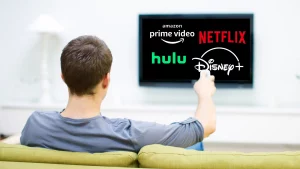Introduction
In the rapidly evolving world of digital entertainment, streaming platforms have become an integral part of our daily lives. From binge-watching TV series to enjoying the latest movies, these platforms provide endless content at our fingertips. However, as the market becomes more saturated and competitive, streaming services are continuously innovating to attract and retain subscribers. One of the most significant trends in recent years is the introduction of subscription tiers. This article delves into the changes in streaming subscription tiers and what they mean for consumers.
The Evolution of Streaming Services

-
The Early Days
In the early days of streaming, platforms like Netflix and Hulu offered a one-size-fits-all subscription model. Users paid a fixed monthly fee for unlimited access to the entire content library. This model was straightforward and easy to understand, contributing to the rapid growth of these services.
-
The Rise of Competition
As more players entered the market, including Amazon Prime Video, Disney+, HBO Max, and others, the competition for subscribers intensified. Each platform sought to differentiate itself by offering exclusive content, original productions, and unique features. This led to the realization that a single subscription model might not suit the diverse needs and preferences of all users.
User Preferences and Behavior
Understanding what users want is key for streaming services. Research shows that many people are willing to pay more for better experiences. They like features like ad-free viewing and exclusive shows. As the number of streaming options increases, users also want flexibility. They want to customize their subscriptions to fit their needs.
Key Findings on User Preferences
- Cost Sensitivity: Many users prefer cheaper, ad-supported tiers to save money.
- Quality of Content: Premium tiers are appealing for serious viewers who want high-quality shows and movies.
- Ad Tolerance: Some users accept ads for a lower price, while others will pay more to avoid them.
The Importance of User Engagement
User engagement is key to the success of streaming platforms. Services are increasingly focusing on how to keep viewers coming back. This includes using personalized recommendations and tailored content suggestions. Engaging users helps build loyalty and reduces churn rates. When users feel connected to the platform, they are less likely to cancel their subscriptions. Companies that prioritize user engagement will likely see long-term success in the competitive streaming market.
Introduction of Subscription Tiers

-
What Are Subscription Tiers?
Subscription tiers are different levels of service offered by streaming platforms, each with varying features, content access, and pricing. These tiers allow users to choose a plan that best fits their needs and budget. The concept is not entirely new; traditional cable TV providers have long used tiered pricing models. However, its adoption in the streaming industry marks a significant shift in how these services operate.
-
Why Are Streaming Platforms Adopting Subscription Tiers?
Several factors have driven the adoption of subscription tiers:
- Diverse User Base: Streaming platforms cater to a wide range of users with different preferences and financial capabilities. Subscription tiers allow them to offer tailored options to various segments of their audience.
- Revenue Optimization: By offering multiple pricing options, platforms can maximize their revenue. Premium tiers with additional features or exclusive content can attract higher-paying subscribers, while more affordable tiers can bring in budget-conscious users.
- Competitive Differentiation: Subscription tiers enable platforms to differentiate themselves from competitors. They can introduce unique features or content in higher tiers to stand out in the crowded market.
Examples of Streaming Subscription Tiers

-
Netflix
Netflix, one of the pioneers in the streaming industry, has embraced subscription tiers to cater to its global audience. As of now, Netflix offers three main tiers:
- Basic: This tier provides access to the entire content library but limits streaming to one device at a time and offers standard definition (SD) quality.
- Standard: The standard tier allows streaming on two devices simultaneously and offers high definition (HD) quality.
- Premium: The premium tier supports streaming on up to four devices simultaneously and provides ultra-high definition (UHD) quality, including 4K content.
-
Disney+
Disney+ has also introduced subscription tiers to enhance its offerings:
- Standard: The basic tier provides access to the entire Disney+ library, including Disney, Pixar, Marvel, Star Wars, and National Geographic content, with HD streaming.
- Premium: The premium tier includes all the features of the standard tier but adds the ability to stream on multiple devices simultaneously and access to exclusive content and early releases.
-
Hulu
Hulu offers a more complex tiered structure, catering to different viewing preferences:
- Hulu (With Ads): This tier offers access to the content library with ad-supported streaming.
- Hulu (No Ads): The ad-free tier provides an uninterrupted viewing experience.
- Hulu + Live TV: This tier combines the on-demand content library with live TV channels, offering a comprehensive entertainment package.
The Role of Advertising in Subscription Models
Advertising plays a significant role in the new streaming subscription tiers. Many platforms now offer ad-supported plans at a lower price. This allows users to enjoy content without breaking the bank. However, it also raises questions about user experience. Frequent ads can disrupt the viewing experience, leading some users to prefer ad-free options. Streaming services must strike a balance between affordability and a pleasant viewing experience.
Implications for Content Creation
The growth of subscription tiers affects how content is made and shared. Streaming platforms are investing more in original content to attract subscribers. They want to stand out in a crowded market. This trend can lead to a wider range of shows and movies, catering to different tastes and interests.
Content creators also benefit from this shift. They can explore new ideas and tell unique stories. Streaming services are looking for diverse voices to produce content. This means audiences will likely see more varied programming in the future.
Impact on Consumers

-
Benefits
- Choice and Flexibility: Subscription tiers provide consumers with more choices and flexibility. Users can select a plan that aligns with their viewing habits and budget.
- Access to Premium Features: Higher tiers often come with premium features such as better video quality, simultaneous streaming on multiple devices, and exclusive content.
- Affordability: Lower-priced tiers make streaming services more accessible to budget-conscious consumers.
-
Drawbacks
- Complexity: The introduction of multiple tiers can make it challenging for consumers to understand the differences and choose the right plan.
- Potential for Higher Costs: While lower tiers offer affordability, consumers seeking premium features may end up paying more than they would under a single subscription model.
The Impact of Competition on Pricing
The competition among streaming services is fierce. Each platform wants to attract and retain subscribers. As a result, they often adjust their pricing and offerings. Some platforms may lower prices or introduce limited-time promotions. This helps them stand out in a crowded market. However, constant price changes can confuse consumers. Users may find it challenging to keep track of what each service offers and at what cost.
Challenges Facing Streaming Services
Streaming services face challenges as they adopt these new models. One major issue is content saturation. With so many options available, users can feel overwhelmed. This makes it harder for any single platform to get noticed.
Another challenge is price sensitivity. As more services pop up, users may limit their spending. They might decide to cancel some subscriptions to save money. Additionally, users who choose ad-supported tiers might get tired of ads, leading to frustration.
Future Trends

Image by: Yandex.com
-
Personalized Subscription Models
As streaming platforms continue to gather data on user preferences and behavior, we can expect more personalized subscription models. These models could dynamically adjust pricing and features based on individual usage patterns.
-
Bundling Services
Bundling streaming services with other digital offerings, such as music streaming or cloud storage, could become more common. This approach provides added value to subscribers and enhances customer loyalty.
-
Ad-Supported Tiers
To attract cost-sensitive users, more platforms may introduce ad-supported tiers. These tiers offer lower subscription fees in exchange for occasional advertisements, similar to traditional TV models.
Analysis Table: Streaming Subscription Tier Features
| Streaming Service | Basic Tier | Ad-Free Tier | Premium Tier | Unique Features |
| Netflix | $6.99/mo | $15.49/mo | $19.99/mo | 4K streaming, offline downloads |
| Hulu | $7.99/mo | $14.99/mo | $70.99/mo | Live TV, add-ons |
| Disney+ | $7.99/mo | $10.99/mo | N/A | Bundles with Hulu and ESPN+ |
| Amazon Prime Video | $8.99/mo | Included with Prime | $14.99/mo | Amazon Originals |
| HBO Max | $9.99/mo | $15.99/mo | N/A | Access to Warner Bros. films |
Comparative Table: Market Share of Streaming Platforms
| Streaming Service | Market Share (%) | Primary Audience | Content Type |
| Netflix | 30% | General audiences | Original series/movies |
| Hulu | 13% | Young adults | Current TV shows |
| Disney+ | 12% | Families and children | Family-friendly content |
| Amazon Prime Video | 10% | Prime members | Varied, with many originals |
| HBO Max | 8% | Adults and cinephiles | Premium films/series |
Conclusion
The introduction of streaming subscription tiers marks a significant shift in the digital entertainment landscape. By offering diverse options, streaming platforms can cater to a broader audience and optimize their revenue. For consumers, this means more choices and flexibility, but also the need to navigate a more complex array of options. As the industry continues to evolve, we can expect further innovations in subscription models, enhancing the overall streaming experience.












